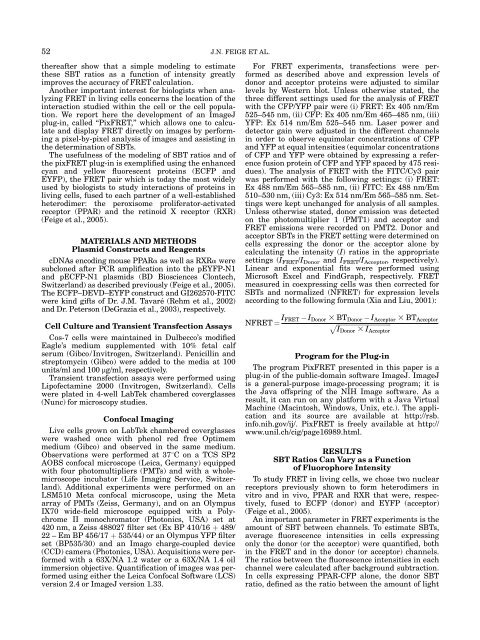PixFRET, an ImageJ plug-in for FRET calculation ... - ResearchGate
PixFRET, an ImageJ plug-in for FRET calculation ... - ResearchGate
PixFRET, an ImageJ plug-in for FRET calculation ... - ResearchGate
- No tags were found...
Create successful ePaper yourself
Turn your PDF publications into a flip-book with our unique Google optimized e-Paper software.
52 J.N. FEIGE ET AL.thereafter show that a simple model<strong>in</strong>g to estimatethese SBT ratios as a function of <strong>in</strong>tensity greatlyimproves the accuracy of <strong>FRET</strong> <strong>calculation</strong>.Another import<strong>an</strong>t <strong>in</strong>terest <strong>for</strong> biologists when <strong>an</strong>alyz<strong>in</strong>g<strong>FRET</strong> <strong>in</strong> liv<strong>in</strong>g cells concerns the location of the<strong>in</strong>teraction studied with<strong>in</strong> the cell or the cell population.We report here the development of <strong>an</strong> <strong>ImageJ</strong><strong>plug</strong>-<strong>in</strong>, called ‘‘<strong>Pix<strong>FRET</strong></strong>,’’ which allows one to calculate<strong>an</strong>d display <strong>FRET</strong> directly on images by per<strong>for</strong>m<strong>in</strong>ga pixel-by-pixel <strong>an</strong>alysis of images <strong>an</strong>d assist<strong>in</strong>g <strong>in</strong>the determ<strong>in</strong>ation of SBTs.The usefulness of the model<strong>in</strong>g of SBT ratios <strong>an</strong>d ofthe pix<strong>FRET</strong> <strong>plug</strong>-<strong>in</strong> is exemplified us<strong>in</strong>g the enh<strong>an</strong>cedcy<strong>an</strong> <strong>an</strong>d yellow fluorescent prote<strong>in</strong>s (ECFP <strong>an</strong>dEYFP), the <strong>FRET</strong> pair which is today the most widelyused by biologists to study <strong>in</strong>teractions of prote<strong>in</strong>s <strong>in</strong>liv<strong>in</strong>g cells, fused to each partner of a well-establishedheterodimer: the peroxisome proliferator-activatedreceptor (PPAR) <strong>an</strong>d the ret<strong>in</strong>oid X receptor (RXR)(Feige et al., 2005).MATERIALS AND METHODSPlasmid Constructs <strong>an</strong>d ReagentscDNAs encod<strong>in</strong>g mouse PPARa as well as RXRa weresubcloned after PCR amplification <strong>in</strong>to the pEYFP-N1<strong>an</strong>d pECFP-N1 plasmids (BD Biosciences Clontech,Switzerl<strong>an</strong>d) as described previously (Feige et al., 2005).The ECFP–DEVD–EYFP construct <strong>an</strong>d GI262570-FITCwere k<strong>in</strong>d gifts of Dr. J.M. Tavaré (Rehm et al., 2002)<strong>an</strong>d Dr. Peterson (DeGrazia et al., 2003), respectively.Cell Culture <strong>an</strong>d Tr<strong>an</strong>sient Tr<strong>an</strong>sfection AssaysCos-7 cells were ma<strong>in</strong>ta<strong>in</strong>ed <strong>in</strong> Dulbecco’s modifiedEagle’s medium supplemented with 10% fetal calfserum (Gibco/Invitrogen, Switzerl<strong>an</strong>d). Penicill<strong>in</strong> <strong>an</strong>dstreptomyc<strong>in</strong> (Gibco) were added to the media at 100units/ml <strong>an</strong>d 100 lg/ml, respectively.Tr<strong>an</strong>sient tr<strong>an</strong>sfection assays were per<strong>for</strong>med us<strong>in</strong>gLipofectam<strong>in</strong>e 2000 (Invitrogen, Switzerl<strong>an</strong>d). Cellswere plated <strong>in</strong> 4-well LabTek chambered coverglasses(Nunc) <strong>for</strong> microscopy studies.Confocal Imag<strong>in</strong>gLive cells grown on LabTek chambered coverglasseswere washed once with phenol red free Optimemmedium (Gibco) <strong>an</strong>d observed <strong>in</strong> the same medium.Observations were per<strong>for</strong>med at 378C on a TCS SP2AOBS confocal microscope (Leica, Germ<strong>an</strong>y) equippedwith four photomultipliers (PMTs) <strong>an</strong>d with a wholemicroscope<strong>in</strong>cubator (Life Imag<strong>in</strong>g Service, Switzerl<strong>an</strong>d).Additional experiments were per<strong>for</strong>med on <strong>an</strong>LSM510 Meta confocal microscope, us<strong>in</strong>g the Metaarray of PMTs (Zeiss, Germ<strong>an</strong>y), <strong>an</strong>d on <strong>an</strong> OlympusIX70 wide-field microscope equipped with a PolychromeII monochromator (Photonics, USA) set at420 nm, a Zeiss 488027 filter set (Ex BP 410/16 þ 489/22 – Em BP 456/17 þ 535/44) or <strong>an</strong> Olympus YFP filterset (BP535/30) <strong>an</strong>d <strong>an</strong> Imago charge-coupled device(CCD) camera (Photonics, USA). Acquisitions were per<strong>for</strong>medwith a 63X/NA 1.2 water or a 63X/NA 1.4 oilimmersion objective. Qu<strong>an</strong>tification of images was per<strong>for</strong>medus<strong>in</strong>g either the Leica Confocal Software (LCS)version 2.4 or <strong>ImageJ</strong> version 1.33.For <strong>FRET</strong> experiments, tr<strong>an</strong>sfections were per<strong>for</strong>medas described above <strong>an</strong>d expression levels ofdonor <strong>an</strong>d acceptor prote<strong>in</strong>s were adjusted to similarlevels by Western blot. Unless otherwise stated, thethree different sett<strong>in</strong>gs used <strong>for</strong> the <strong>an</strong>alysis of <strong>FRET</strong>with the CFP/YFP pair were (i) <strong>FRET</strong>: Ex 405 nm/Em525–545 nm, (ii) CFP: Ex 405 nm/Em 465–485 nm, (iii)YFP: Ex 514 nm/Em 525–545 nm. Laser power <strong>an</strong>ddetector ga<strong>in</strong> were adjusted <strong>in</strong> the different ch<strong>an</strong>nels<strong>in</strong> order to observe equimolar concentrations of CFP<strong>an</strong>d YFP at equal <strong>in</strong>tensities (equimolar concentrationsof CFP <strong>an</strong>d YFP were obta<strong>in</strong>ed by express<strong>in</strong>g a referencefusion prote<strong>in</strong> of CFP <strong>an</strong>d YFP spaced by 475 residues).The <strong>an</strong>alysis of <strong>FRET</strong> with the FITC/Cy3 pairwas per<strong>for</strong>med with the follow<strong>in</strong>g sett<strong>in</strong>gs: (i) <strong>FRET</strong>:Ex 488 nm/Em 565–585 nm, (ii) FITC: Ex 488 nm/Em510–530 nm, (iii) Cy3: Ex 514 nm/Em 565–585 nm. Sett<strong>in</strong>gswere kept unch<strong>an</strong>ged <strong>for</strong> <strong>an</strong>alysis of all samples.Unless otherwise stated, donor emission was detectedon the photomultiplier 1 (PMT1) <strong>an</strong>d acceptor <strong>an</strong>d<strong>FRET</strong> emissions were recorded on PMT2. Donor <strong>an</strong>dacceptor SBTs <strong>in</strong> the <strong>FRET</strong> sett<strong>in</strong>g were determ<strong>in</strong>ed oncells express<strong>in</strong>g the donor or the acceptor alone bycalculat<strong>in</strong>g the <strong>in</strong>tensity (I) ratios <strong>in</strong> the appropriatesett<strong>in</strong>gs (I <strong>FRET</strong> /I Donor <strong>an</strong>d I <strong>FRET</strong> /I Acceptor , respectively).L<strong>in</strong>ear <strong>an</strong>d exponential fits were per<strong>for</strong>med us<strong>in</strong>gMicrosoft Excel <strong>an</strong>d F<strong>in</strong>dGraph, respectively. <strong>FRET</strong>measured <strong>in</strong> coexpress<strong>in</strong>g cells was then corrected <strong>for</strong>SBTs <strong>an</strong>d normalized (N<strong>FRET</strong>) <strong>for</strong> expression levelsaccord<strong>in</strong>g to the follow<strong>in</strong>g <strong>for</strong>mula (Xia <strong>an</strong>d Liu, 2001):N<strong>FRET</strong> ¼ I <strong>FRET</strong> I Donor 3 BT Donor I Acceptor 3 BT AcceptorpffiffiffiffiffiffiffiffiffiffiffiffiffiffiffiffiffiffiffiffiffiffiffiffiffiffiffiffiffiffiffiffiffiffiI Donor 3 I AcceptorProgram <strong>for</strong> the Plug-<strong>in</strong>The program <strong>Pix<strong>FRET</strong></strong> presented <strong>in</strong> this paper is a<strong>plug</strong>-<strong>in</strong> of the public-doma<strong>in</strong> software <strong>ImageJ</strong>. <strong>ImageJ</strong>is a general-purpose image-process<strong>in</strong>g program; it isthe Java offspr<strong>in</strong>g of the NIH Image software. As aresult, it c<strong>an</strong> run on <strong>an</strong>y plat<strong>for</strong>m with a Java VirtualMach<strong>in</strong>e (Mac<strong>in</strong>tosh, W<strong>in</strong>dows, Unix, etc.). The application<strong>an</strong>d its source are available at http://rsb.<strong>in</strong>fo.nih.gov/ij/. <strong>Pix<strong>FRET</strong></strong> is freely available at http://www.unil.ch/cig/page16989.html.RESULTSSBT Ratios C<strong>an</strong> Vary as a Functionof Fluorophore IntensityTo study <strong>FRET</strong> <strong>in</strong> liv<strong>in</strong>g cells, we chose two nuclearreceptors previously shown to <strong>for</strong>m heterodimers <strong>in</strong>vitro <strong>an</strong>d <strong>in</strong> vivo, PPAR <strong>an</strong>d RXR that were, respectively,fused to ECFP (donor) <strong>an</strong>d EYFP (acceptor)(Feige et al., 2005).An import<strong>an</strong>t parameter <strong>in</strong> <strong>FRET</strong> experiments is theamount of SBT between ch<strong>an</strong>nels. To estimate SBTs,average fluorescence <strong>in</strong>tensities <strong>in</strong> cells express<strong>in</strong>gonly the donor (or the acceptor) were qu<strong>an</strong>tified, both<strong>in</strong> the <strong>FRET</strong> <strong>an</strong>d <strong>in</strong> the donor (or acceptor) ch<strong>an</strong>nels.The ratios between the fluorescence <strong>in</strong>tensities <strong>in</strong> eachch<strong>an</strong>nel were calculated after background subtraction.In cells express<strong>in</strong>g PPAR-CFP alone, the donor SBTratio, def<strong>in</strong>ed as the ratio between the amount of light
















